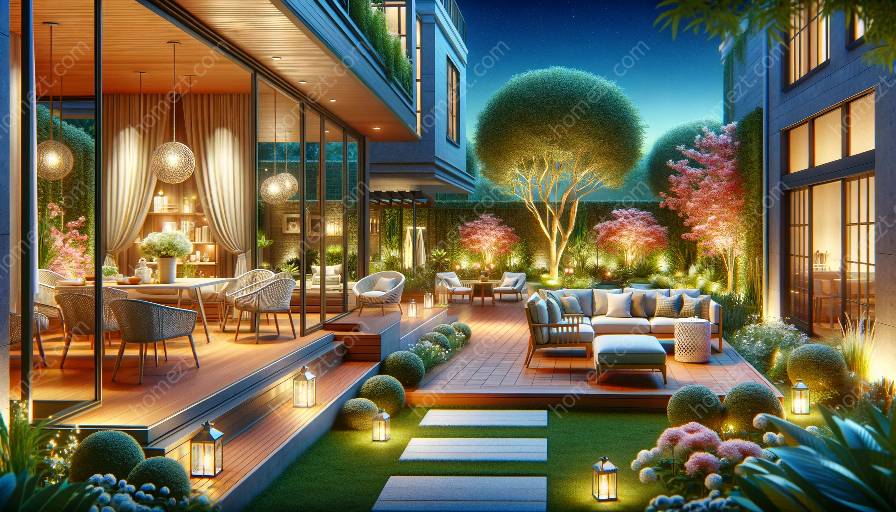Rooftop gardens are a unique and innovative way to create green spaces in urban environments, but they come with their own set of challenges. In this article, we'll explore the challenges and innovations in rooftop gardens, and how they relate to outdoor living spaces and garden design, as well as interior design and styling.
Challenges of Rooftop Gardens
Building a garden on a rooftop presents several challenges that must be addressed in order to create a successful and sustainable green space. Some of the main challenges include:
- Structural Considerations: Rooftops have weight-bearing limitations that need to be carefully taken into account when designing a garden. Structural engineers must ensure that the roof can support the additional weight of plants, soil, and other garden elements.
- Wind and Sun Exposure: Rooftops are often exposed to strong winds and direct sunlight, which can impact the health and growth of plants. Proper planning and selection of wind-resistant and sun-tolerant plants are essential to overcome these challenges.
- Water Management: Rooftop gardens require efficient irrigation systems to ensure that plants receive adequate water without causing damage to the building's structure. Proper drainage and waterproofing are also critical to prevent water leakage.
- Access and Maintenance: Accessing a rooftop garden for maintenance and care can be challenging, especially in tall buildings. It's important to consider how gardeners and maintenance personnel will access the garden and manage its upkeep.
Innovations in Rooftop Gardens
Despite the challenges, innovative solutions have been developed to make rooftop gardens not only feasible but also aesthetically pleasing and sustainable. Some of the key innovations include:
- Lightweight Growing Mediums: Advances in lightweight soil and growing mediums have made it possible to create lush rooftop gardens without overburdening the structure. These specialized mediums provide the necessary nutrients and support for plant growth while minimizing weight.
- Modular Garden Systems: Modular and pre-fabricated garden systems allow for easy installation and reconfiguration of rooftop gardens. These systems often include components such as raised planters, seating areas, and built-in irrigation, making rooftop garden design more efficient and flexible.
- Green Roof Technology: Green roof systems utilize specialized layers to provide insulation, drainage, and vegetation support, effectively transforming the rooftop into a living, sustainable environment. These systems offer numerous benefits, including energy efficiency, stormwater management, and improved air quality.
- Vertical Gardens: Vertical gardening techniques have gained popularity in rooftop garden design, allowing for the cultivation of plants on vertical surfaces such as walls and pillars. Vertical gardens maximize space utilization and create striking visual impact in outdoor living areas.
- Seating and Entertainment Areas: Incorporating seating, dining, and relaxation areas within the rooftop garden allows for social gatherings and enjoyment of the outdoor environment. Careful placement of furniture and amenities can optimize the use of space and create a welcoming atmosphere.
- Plant Selection and Seasonal Variations: Choosing a diverse range of plants that bloom at different times of the year can ensure year-round visual interest and create dynamic, ever-changing landscapes within the outdoor living space.
- Functional Elements: Introducing functional elements such as pergolas, shade structures, and lighting can enhance the usability and comfort of the rooftop garden, extending its appeal for outdoor activities during both day and night.
- Natural Light and Views: Incorporating rooftop gardens can provide natural light and green vistas, enriching the interior spaces with a sense of openness and connection to nature. Properly positioned windows and openings can frame the garden views and enhance the ambiance within the building.
- Biophilic Design Elements: Incorporating biophilic design principles, such as natural materials, textures, and patterns, can further establish a harmonious relationship between the interior environment and the rooftop garden, promoting wellbeing and visual continuity.
- Indoor-Outdoor Transitions: Creating seamless transitions between indoor and outdoor spaces through design elements such as large glazed doors, outdoor terraces, or green atriums can promote a sense of fluidity and unity throughout the building.
Rooftop Gardens and Outdoor Living Spaces
Integrating rooftop gardens with outdoor living spaces presents exciting opportunities to enhance the connection between nature and urban living. Thoughtful garden design and landscaping can create inviting and functional outdoor environments that complement the architecture and style of the building. Considerations for rooftop gardens in outdoor living spaces include:
Rooftop Gardens and Interior Design
The presence of rooftop gardens can influence the interior design and styling of the building, creating a seamless connection between indoor and outdoor spaces. When considering rooftop gardens in the context of interior design, aspects to take into account include:
By addressing the challenges and embracing the innovations in rooftop gardens, it's possible to create captivating and sustainable green spaces that harmonize with both outdoor living spaces and garden design, as well as interior design and styling.


























